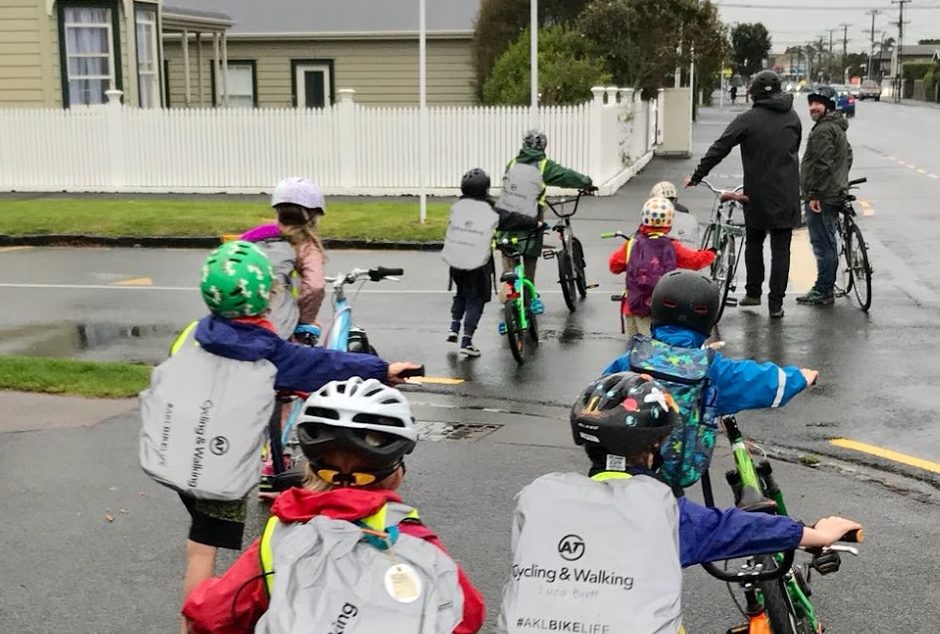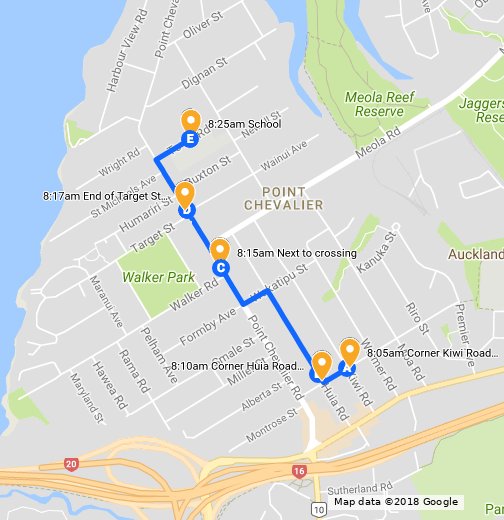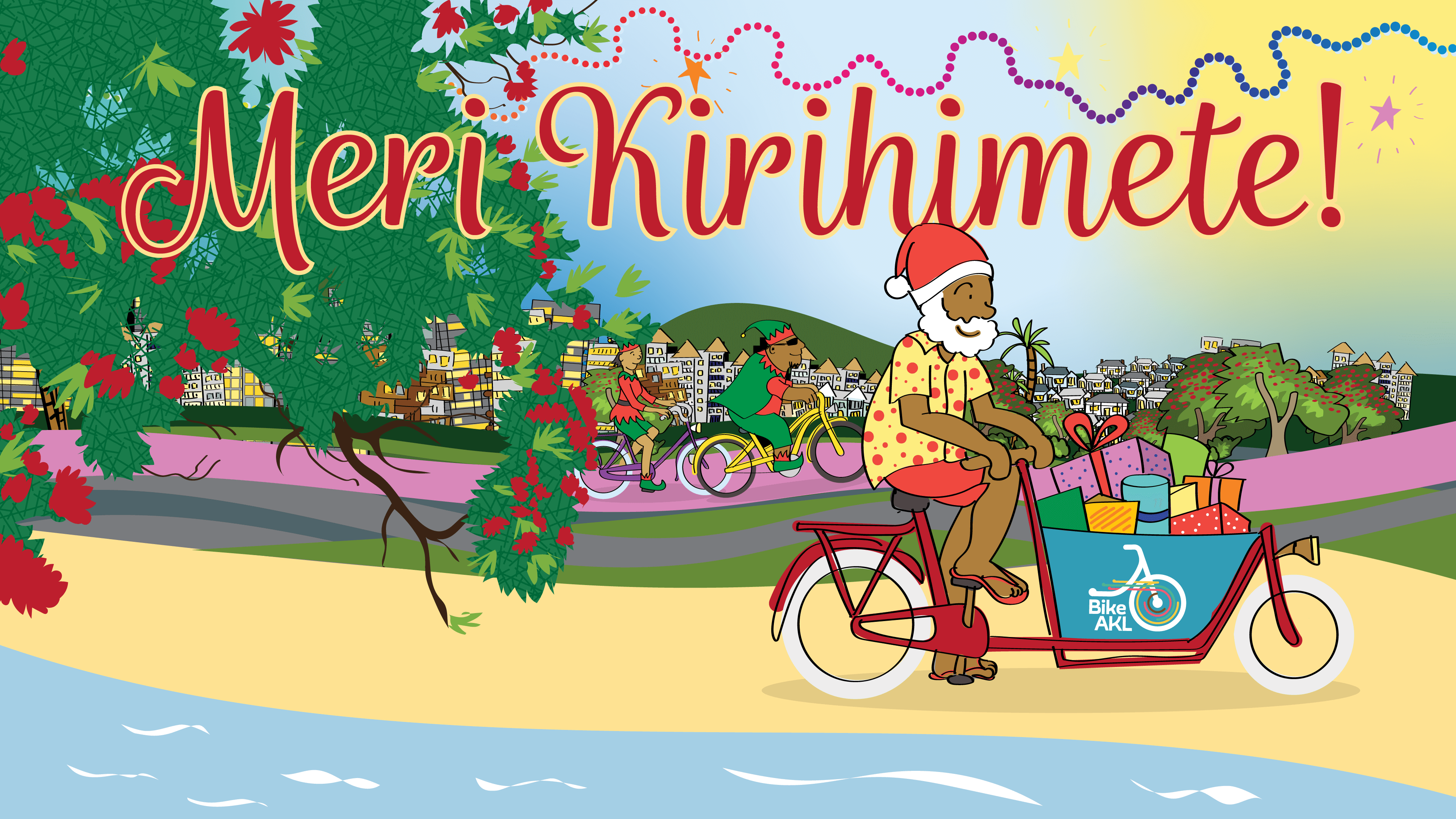Around the world, a bike bus (or ‘cycle train’) is an increasingly common phenomenon. As seen in Ireland and Italy, it’s basically a ‘walking school bus’ on wheels: a way for young children to ride to school safely while developing future independence.
And now, the bike train is pulling into Auckland. Local parent Matt Fordham and Pt Chevalier School’s Sustainability Champion Keren Rego were motivated to start the Pt Chev Cycle Train by a sense of frustration that little kids want to bike to school but the streets aren’t safe enough – and a sense of optimism that there would be strong demand.
Below, Matt explains how the initiative has become an express to success, and how a coming local cycleway project has the power to make it even better.
Every morning from Monday to Friday, helped by a roster of other parents, I guide up to a dozen kids on bikes to Pt Chevalier School, a trip of approximately 1.5 km that takes us about 20 minutes. Along the way, we cross side streets, busy roads, zebra crossings, and driveways, ride past dairies and cafes dinging our bells, and share the footpath with busy morning foot traffic headed to school and elsewhere. The kids ride rain or shine, and most of them are so up for it that it’s become a huge motivator in the mornings to get them dressed and out the door in time to catch the ‘train’ – something a lot of parents of young kids usually struggle with each morning.
The Pt Chev Cycle Train was established at the beginning of winter, and we’ve already had a 50% increase of registrations during the coldest months of the year. A dozen children signed up to start with, and we’re now at 18, although different kids use it on different days, so on a busy day we typically have a dozen children riding with two or more parent helpers. By the end of summer, we anticipate having more than 30 kids signed up, at which point we’ll need to split the Cycle Train into two or three groups.
Officially, the train goes to the primary school (Pt Chevalier School), although we also have some younger siblings of kindergarten age who tag along when their parents are leading the train. One morning a week, I ride at the back with my one-year-old daughter in a bike trailer too. Even at that young age, watching what the older kids are doing is inspiring her to get on a balance bike more and more.
While we set up the Cycle Train to reduce vehicle traffic around our suburb and give kids a healthy start to the day, safety is our primary concern each morning. For now, to ensure the safety of everyone involved, we have to ride with the Cycle Train kids on the footpath, and we dismount our bikes and walk them across every crossing and side street. The biggest risk we face is driveways: here are 80 of them along the route, and almost every morning we encounter a driver reversing out of a driveway that cannot see our small kids.
Our route stretches almost the length of the suburb – from the corner of Tui Street and Kiwi Road, to the school on Te Ra Road.
Safety challenges faced, and initiatives we’ve undertaken
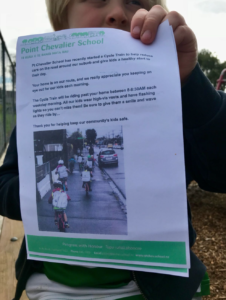
- Route planning. We have arrived at a route we believe is the safest possible. This ensures kids ride with the flow of traffic almost the entire way to school, increasing the chance drivers will be looking our way when leaving driveways. We’ve also ended up riding during what seems to be a relatively quiet time in the morning in terms of cars leaving driveways: we travel between 8 and 8.30am, and I have noticed that there is more driveway activity between 8.30-9am.
- Safety gear. With the support of AT’s Travelwise programme, the kids have had bike checks and been provided with high-vis vests, lights, and backpack covers.
- Competence training. While we were setting the programme up, we arranged for AT staff from Travelwise and the Cycling and Walking team to come to the school and give the Cycle Train kids skills training.
- Driveway training. We requested AT provide training for the children specifically targeted to how to respond to incidents when cars are coming out of driveways. As a parent group that has now had experience riding a dozen kids past 80 driveways every weekday morning for months, we’ve developed this further into our own strategy for dealing with cars coming out of driveways, and we test the kids with dummy runs every now and then, to keep it top of mind.
- Mail drop. We did a mailbox drop to every house along the Cycle Train route, letting them know we’ll be passing by in the mornings (see picture).
- Parent weekend training. One Sunday afternoon, we rode the route with the parents that lead the train – and their kids – stopping at particularly risky points and discussing our current approaches to safety and how they might be improved. This ended with a meal at the local bowling club and a convoy ride home in the dark for some of the younger kids.
- Safety review. None of us parents are experts in road design or safety, and we are always on the lookout for people who are to give us advice. One of AT’s walking and cycling team rode the route with us to give feedback, and we would love to hear from anyone in the Bike Auckland community who could offer their time and expertise.
Benefits of the bike train so far
- Happy kids. The Cycle Train is a really nice warm-up for the children each morning, and they’ve developed a real ‘bike gang’ group identity. When I used to ride with just my son, he would take his hi-viz vest as soon as he got to school; now he wears it – and sometimes even his helmet – right into his class. (We’ve even had a little bit of romance on the ‘train’: one of the young girls told one of the boys in no uncertain terms that ‘he loved her’!)
- Less traffic– both on the roads we travel AND out the front of the school circling for a car park. The cycle train has run for almost 100 days now. Given the number of kids on the train, we’ve probably saved around 800 car trips in that time – and it’ll easily be 1,000 by the end of the year. Like many schools around Auckland, we have issues with too many cars clogging up the streets around the school at drop-off time; every car we take off the road relieves that pressure.
- More quality time for parents and kids. We have a roster of about 20 parents who help out with the Cycle Train, which means most parents only do one morning a week – some even less often than that. Some of the parents have found this means they can leave for work earlier and come home earlier in the evenings. Also, because the kids are motivated to get ready for school so they can catch the ‘train’ in time, mornings can be less of a struggle, something everyone would appreciate.
- Discovering the potential of the neighbourhood on wheels. We are slowly introducing the kids to more of the suburb off the back of the Cycle Train. A bunch of the kids started biking regularly to football on Saturday mornings; we ran a night-time ride on a Sunday, just for fun; and one of the local cafes on the route gave the kids free hot chocolates one frosty morning to say ‘well done’ for making it through winter. I’m also going to organise a longer ride in the school holidays for the Cycle Train kids – to further introduce them to the idea that biking gives them independence and connection to their city.
- Getting something going. It’s been really great to see the momentum the Cycle Train now has. There wasn’t a ‘template’ we could use when we started, and there were a few tricky things we had to work out in order to have it run smoothly. We’re confident that as the weather turns warmer and more kids and parents join, the effort we’ve put in at the beginning means it will pretty much run itself.
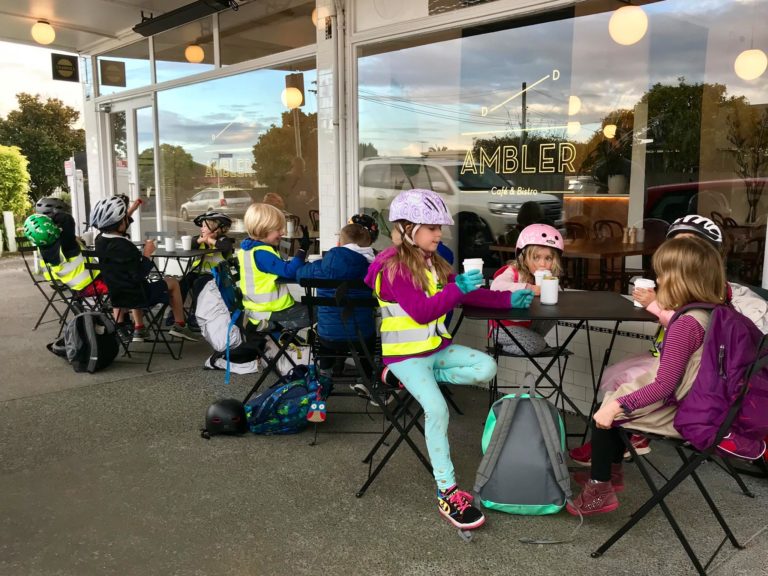
Risks we still encounter
As we’re on the footpath and not the road, by far the biggest risk the kids face each morning is cars coming out of driveways. Our kids pass roughly 80 driveways along their route to school. Reversing cars are particularly dangerous, as most of our children are too short to be seen by a rear-view mirror (and vehicles are getting bigger and bigger). There are also many houses with high fences right up to the footpath, so it is almost impossible for a driver to see our kids until it is too late.
We’re doing as much as we can to make it possible for our kids to bike around Pt Chev safely. We’ve done the mail drop; we’ve done the driveway training, and we’ve developed our own strategies to deal with these locations, to minimise the risk of our Cycle Train kids encountering a car. The rest is in the hands of others: drivers, both local and passing through; other parents doing drop-off; and of course the way our streets are designed and enforced.
Pt Chevalier School alone has a very active population. Every day, around 200 bikes and scooters are parked at the school and our Cycle Train represents just a small part of those overflowing racks. Given the number of scooters and bikes, big and small, outside the primary school, local kindy, and daycares, we know there are already hundreds of very young children already making their way around the suburb on two wheels, who’ll be hoping to bike on their own to school and other places in a few short years. And a couple of months back we had our first ‘graduate’ from the Cycle Train, who is now biking to school on his own. [Ed note: many of the primary children move on to the nearby intermediate school, which also has a very high proportion of kids who walk, bike and scoot].
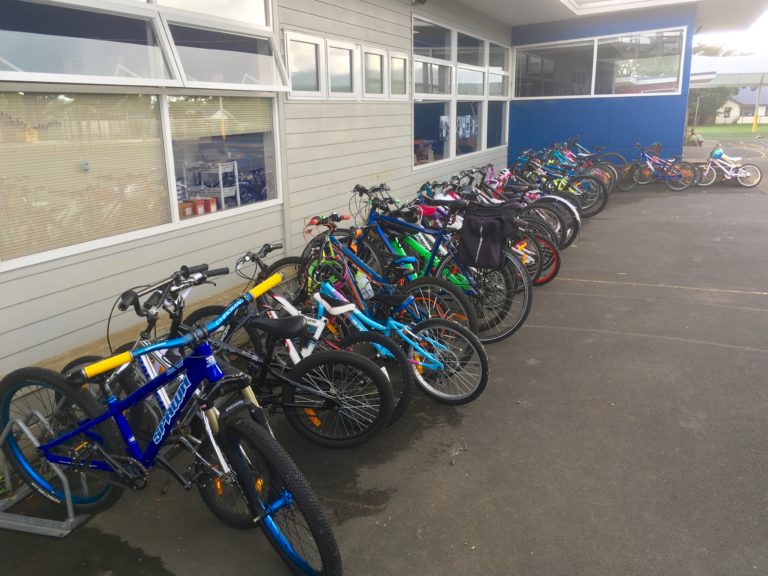
So it’s great that AT is planning to add cycleways in our suburb, up Pt Chevalier Road as far as Meola Road, and then along Meola Road into Westmere. These are our busiest and most direct streets, with on average 16,000 vehicle movements a day at 50kph (although of course some go even faster).
But those cycleways alone won’t be sufficient to make it safe for the children I ride with. Of the 80-odd driveways our Cycle Train kids pass each morning, the proposed route would cover about two-thirds – leaving about 26 driveway entrances they won’t be protected from on the stretch of Pt Chev Road between Meola Road and Te Ra Road, where the school is. Most mornings we encounter a car reversing out of at least one driveway on this stretch.
To put this into perspective, a dozen kids riding that unprotected stretch of 26 driveways each morning and afternoon means there are 3,000 occasions each and every week where a child is passing a driveway. More than 100,000 ‘look out for sneaky driveways’ during the school year – just for our Cycle Train, with adults actively supervising every moment.
Something like 200 kids bike or scoot to the primary school every morning, some in family groups, many traveling independently. Some come via the main road, and others via the ‘back street’ of Walford, which is just as busy with cars each morning and afternoon. Others arrive from the northern end of the peninsula. Intermediate students also ride this route in big numbers, so you’re talking millions of moments in the school year that a young child – any child, not just our Cycle Train kids – bikes or scoots past a driveway on the stretch of Pt Chevalier Road between Meola and Te Ra left unprotected by the proposed route.
And this doesn’t include the north end of Pt Chevalier Road, crossing the side streets along the way, or the equally popular route along Walford Rd which includes driveways and streets to cross.
So I’d like to see AT build the route that’s been proposed PLUS extend protection along Point Chevalier Road at least as far as the primary school. And to be honest, if I had to choose between fixing Meola Road and building the extension to the school, I’d opt for prioritising serving the needs of our youngest children and I believe other parents and teachers at the primary school would back me on this. Children are so much more vulnerable than adults, and we should prioritise providing safe ways for them to travel around our neighbourhood.
— Matt Fordham
A note from Bike Auckland: We’re calling on Auckland Transport to work with its new safety mandate and budget plus enhanced Local Board funding, to ensure that new neighbourhood cycleways are delivered in tandem with other projects that create safer side streets and connections to local destinations, especially schools. Main street’ cycleways are not just for busy people passing through – they’re an investment in the health of our communities and our children.
We urge AT and the Local Board (Albert-Eden) to bridge the crucial safety gap identified by Matt and the Pt Chevalier School community, plus safe connections to the intermediate school on Pasadena Ave – this is a golden opportunity to support local children and their families who are already riding and encourage many more.

